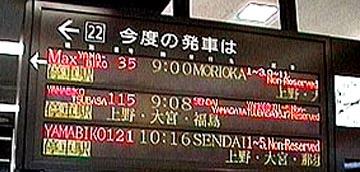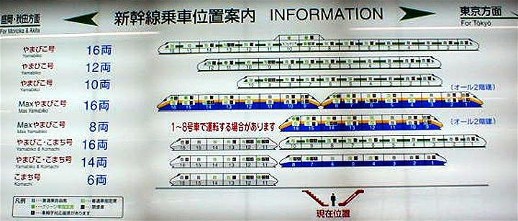Train Schedules and Miscellaneous Train Tips |
 |
 |
 |
 |
 |
 |
 |
 |
 |
 |
 |
 |
 |
 |
 |
 |
 |
 |
 |
 |
|
|
|
|
|
|
|
|
|
|
|
|
|
|
|
|
|
|
|
|
|
|
|
|
|
|
|
|
|
|
Once you arrive in Japan, the place where you exchange your Rail Pass voucher might have some English timetables for Shinkansen and Limited Express trains upon request, but none for local trains (see example at right). This type of timetable may be all you need to plan your travels.
|
|
|
|
|
|
 |
|
|
|
|
|
|
|
|
Telephone Assistance English-language assistance and travel information is available during working hours on the Japan Travel Phone, toll-free outside of Tokyo and Kyoto 0088-22-4800. Local call in Tokyo 03-3201-3331 or Kyoto 075-371-5649. JR has an English-language hotline in Tokyo at 03-3423-0111, open weekdays 10 AM to 6 PM.
|
|
|
|
|
|
|
|
|
|
|
Online Schedules. I highly recommendHyper-Dia's English timetable or Jourdan Train Route Finder (click on the word "English" if the Japanese language page appears). These online services search specific dates and times, and then display multiple suggested choices. Hyperdia allows narrowed search parameters at the bottom of each result page, such as limiting results to only JR trains or excluding Nozomi-class trains (both helpful if you'll be using a JR Pass). (If traveling on the Tokaido (Tokyo-Osaka) or San'yo (Osaka-Hakata) Shinkansen using a Rail Pass, you'll need to click this timetable link to see Hikari trains, since only the fastest Nozomi trains will appear as suggested "courses." Rail Pass is not valid on Nozomi trains.) These search engines are far more user-friendly than even JR's Japanese-language Cyberstation discussed below. If you can read Japanese, the Japanese language pages for both of these sites provide more options for searching, and Jourdan's Japanese page allows keying-in ro-maji that results in Kanji choices.
Japanese Language Schedules. Monthly paperback jikokuhyou (timetables) are published monthly in Japan and sold just about wherever newspapers are sold, and range in price from about 400 yen for a small print version to about 1,000 yen for the deluxe full-sized version. I usually buy one at a kiosk located adjacent to the JR ticket office at Narita airport. I've also seen them for sale in Japanese bookstores in the U.S. The jikokuhyou are only in Japanese, but with a little practice, relatively easy to use if you know the kanji for main cities. The full size version, which all train station ticket offices keep on hand, also lists cities in hiragana. Hints for reading jikokuhyou are discussed on the next page. Another interesting thing about jikokuhyou is that virtually all public transportation, including buses and domestic air routes are listed in them.
JR Group's web site, called Cyberstation (Japanese only) includes seat availability inquiry (limited to one month in advance), real time schedule inquiry (similar to US Airline arrival information) and fare information. You really need to know the train route names (Touhoku Shinkansen, for example) and kanji to effectively use this site, however. Availability is generally only a worry during peak holiday periods, such as: Golden Week, 29 April to 6 May, Obon (11-20 August), and New Years (28 December to 6 January).
Reserve versus 'On The Fly' If you're a real adventurer, and especially if you're not traveling during a peak travel period, with JR Rail Pass in hand, you can freely board any JR train (except Nozomi) and sit even in an empty reserved seat. If a conductor comes around, just show him your Pass. He may move you to a reserved seat that he knows will not be filled on a subsequent stop. If you have destinations in mind, you can obtain reserved seats and assistance in advance at the green midori no mado-guchi (reserved ticket windows) located in each JR station as discussed in the JR Rail Pass page.
|
|
|
|
|
|
|
|
|
|
|
Japanese Timetables--How to Read.
Below is a page from the large deluxe jikokuhyou (timetable) mentioned above. The jikokuhyou is divided into sections of train routes, such as the Touhoku Shinkansen shown below. Maps of Japan rail lines with page references are found at the front of the jikokuhyou. You should note that the large deluxe version (about 1,000 yen) is the only jikokuhyou that lists city names on the first page of each section in hiragana (as shown below); all smaller versions list them in kanji only. These full-size jikokuhyou are the kind that are found in each eki (train station) on the desks near the midori-no-madoguchi (green window/reserved ticket) counters to assist riders in choosing which train to reserve. See Obtaining Reserved Seat Tickets, discussed on the Japan Rail Pass page.
|
|
|
|
|
|
|
|
|
 |
|
|
|
|
|
|
|
|
|
|
|
|
|
|
|
|
 |
|
|
|
|
|
|
|
|
Station Names All rail and subway stations display station names in both Japanese and Roman letters on their platforms. A station's name is in the center of the signboard, in large letters; the names of the previous station and the next station are at the bottom of the signboard, in smaller letters.
|
|
|
|
|
|
|
|
 |
|
|
|
|
|
|
Station Displays Most stations have electronic displays for each track that show departure times and train names. Shinkansen and large city station displays alternate between English and Japanese, as shown in the shot at right that announces the next three departures on Tokyo Station's track 22 for the Touhoku Shinkansen.
|
|
|
|
|
|
|
|
 |
|
|
|
|
|
|
|
|
Where to Stand on Train Platform On each train platform (noriba or ho-mu), there are small signs that designate where specific car numbers stop on the platform. These signs are usually at eye level or are painted right onto the platform at "shoe level." You need to know the name and number of the train you intend to ride; for example, "Max Yamabiko 35," as well as your car number. This information appears on your reserved seat ticket.
For Shinkansen, it is also helpful to know the total number of cars on the train, for example, a 16 car train, which information can usually be found on electronic overhead displays in the stations near the escalators up to the Shinkansen track level (refer to the picture below).
The platform car number designation signs will either list specific train names (Yamabiko 35,47,49), or total cars (8 ryou, 16 ryou), then the car number for that "standing" spot. Train cars are consecutively numbered, so you can make your way up or down the platform until you find the place to wait for the car number listed on your reserved seat ticket. Also remember that anyone will help if you ask.
|
|
|
|
|
|
|
|
|
 |
|
|
|
|
 |
|
|
|
|
|
|
|
"You are here"
(before riding escalators up to track level)
|
|
|
|
|
|
|
|
|
|
|
|
|
|
Onboard Announcements Announcements on all Shinkansen and some tokkyuu (limited express trains) are recorded in both Japanese and English. Announcements generally give information about amenities and stops. You can also find electronic sign boards in most green cars (first class) that give news, weather, and stop information in both languages.
Onboard Telephones Shinkansen and some tokkyuu (limited express trains) are equipped with public phones for domestic use, which require use of a "telephone card" (magnetic prepaid card). Telephone cards are usable instead of coins on virtually all Japanese public phones, and can usually be purchased aboard trains. Be advised that these phones do not always work perfectly (similar to poor cellular connections). Cell phone (keitai) use is allowed on trains in Japan, but only in the 'deck,' the space between cars.
|
|
|
|
|
|
Link back to Travel Tip Index
|





